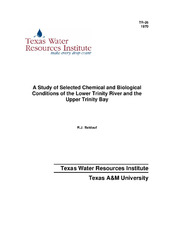| dc.description.abstract | Concern over the effects of water development projects on coastal nurseries prompted the Department of Wildlife Science of Texas A&M University, with the cooperation of the UO So Bureau of Commercial Fisheries, Galveston, to undertake a study of a threatened nursery in the Galveston Bay System.
A long-range program for the development of the Trinity River Drainage Basin includes the construction of several multi-purpose reservoirs along the main river (Fickessen, 1965). Of immediate threat to Galveston Bay nurseries was the reservoir to be constructed at Wallisville, Texas (Trinity River Mile 3.9)0 The site is close to Trinity Bay and the dam will traverse the relatively wide deltaic region of the Trinity River (Figure 2).
The completed dam will serve as an effective barrier to salt water. Approximately 12,500 acres of marsh behind the dam will be come a freshwater conservation pool. The marsh area below the dam (8,200 acres) will also be modified through changes in the freshwater flow.
It is assumed that tile Wallisville Dam will be completed and that many of the conditions described here for the study area will be drastically changed.
The aim of this study was to gather data which would establish file role of the threatened marsh as a nursery for important marine and estuarine species It is recognized that these data will serve in planning and evaluating future water projects of this nature. Data reported here cover the period from March, 1966, through May, 1968. The study was limited to commercially important species with special emphasis given to the shrimps.
The Bureau of Commercial Fisheries had maintained collecting stations in trinity Bay and made several preliminary investigations in the area of the proposed Wallisville Reservoir, but the actual extent to which commercially important species were utilizing these threatened wetlands was unknown. This paper attempts to demonstrate the extent to which the marsh has been utilized by the white shrimp (Penaeus setiferus Linnaeus), the brown shrimp (Penaeus aztecus Ives), the blue crab (Callinectes sapidus Rathburl), and the Gulf menhaden (Brevoortia patronus Goode). Some of the information presented here may be pertinent to an understanding of the same species in other low salinity environments. | en |


